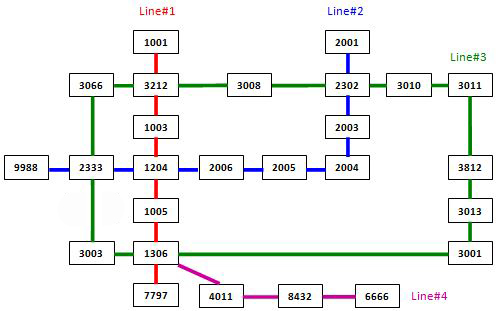In the big cities, the subway systems always look so complex to the visitors. To give you some sense, the following figure shows the map of Beijing subway. Now you are supposed to help people with your computer skills! Given the starting position of your user, your task is to find the quickest way to his/her destination.

Input Specification:
Each input file contains one test case. For each case, the first line contains a positive integer N (≤ 100), the number of subway lines. Then N lines follow, with the i-th (i=1,⋯,N) line describes the i-th subway line in the format:
M S[1] S[2] ... S[M]
where M (≤ 100) is the number of stops, and S[i]'s (i=1,⋯,M) are the indices of the stations (the indices are 4-digit numbers from 0000 to 9999) along the line. It is guaranteed that the stations are given in the correct order -- that is, the train travels between S[i] and S[i+1] (i=1,⋯,M−1) without any stop.
Note: It is possible to have loops, but not self-loop (no train starts from S and stops at S without passing through another station). Each station interval belongs to a unique subway line. Although the lines may cross each other at some stations (so called "transfer stations"), no station can be the conjunction of more than 5 lines.
After the description of the subway, another positive integer K (≤ 10) is given. Then K lines follow, each gives a query from your user: the two indices as the starting station and the destination, respectively.
The following figure shows the sample map.

Note: It is guaranteed that all the stations are reachable, and all the queries consist of legal station numbers.
Output Specification:
For each query, first print in a line the minimum number of stops. Then you are supposed to show the optimal path in a friendly format as the following:
Take Line#X1 from S1 to S2.
Take Line#X2 from S2 to S3.
......
where Xi's are the line numbers and Si's are the station indices. Note: Besides the starting and ending stations, only the transfer stations shall be printed.
If the quickest path is not unique, output the one with the minimum number of transfers, which is guaranteed to be unique.
Sample Input:
4
7 1001 3212 1003 1204 1005 1306 7797
9 9988 2333 1204 2006 2005 2004 2003 2302 2001
13 3011 3812 3013 3001 1306 3003 2333 3066 3212 3008 2302 3010 3011
4 6666 8432 4011 1306
3
3011 3013
6666 2001
2004 3001
Sample Output:
2
Take Line#3 from 3011 to 3013.
10
Take Line#4 from 6666 to 1306.
Take Line#3 from 1306 to 2302.
Take Line#2 from 2302 to 2001.
6
Take Line#2 from 2004 to 1204.
Take Line#1 from 1204 to 1306.
Take Line#3 from 1306 to 3001.
用两个变量min_cnt和min_tranefer保存最少的经过的站点数目和最少的换成车辆,用dfs搜索得出结果
采用了hash值的方法来存储任意两个站点之间的路号线,在dfs搜索中采用了剪枝的方法,加快了效率
参考大佬的满分代码如下:
#include<bits/stdc++.h>
using namespace std;
const int N=10010;
vector<vector<int> >ve(N);//每个线路的经停站
unordered_map<int,int>mp;//两个站对应的线路号
vector<int>temp_path,path;//中间保存的路径、结果路径
int vst[N];
int n,k;
int start,en;
int min_cnt,min_transfer;
int transfer(vector<int>v){
//计算此条路径上的换乘的数量
int cnt=-1,preline=0;
for(int i=1;i<v.size();i++){
if(mp[v[i-1]*10000+v[i]]!=preline) cnt++;
preline=mp[v[i-1]*10000+v[i]];
}
return cnt;
}
void dfs(int node,int cnt){//计算从起点到终点的经停站的数量
if(cnt>min_cnt) return;
if(node==en&&(cnt<min_cnt||(cnt==min_cnt&&transfer(temp_path)<min_transfer))){
min_cnt=cnt;
min_transfer=transfer(temp_path);
path=temp_path;
}
if(node==en){
return;
}
for(int i=0;i<ve[node].size();i++){
if(vst[ve[node][i]]==0){
vst[ve[node][i]]=1;
temp_path.push_back(ve[node][i]);
dfs(ve[node][i],cnt+1);
vst[ve[node][i]]=0;
temp_path.pop_back();
}
}
}
int main(){
cin>>n;
for(int i=1;i<=n;i++){
int m,pre,now;
cin>>m>>pre;
for(int j=2;j<=m;j++){
cin>>now;
ve[pre].push_back(now);
ve[now].push_back(pre);
mp[pre*10000+now]=i;
mp[now*10000+pre]=i;
pre=now;
}
}
cin>>k;
for(int i=1;i<=k;i++){
min_cnt=N,min_transfer=N;
cin>>start>>en;
temp_path.clear();
temp_path.push_back(start);
vst[start]=1;
dfs(start,0);
cout<<min_cnt<<endl;
vst[start]=0;
int id=mp[path[0]*10000+path[1]],pre=path[0];
for(int i=2;i<path.size();i++){
if(mp[path[i-1]*10000+path[i]]!=id){
printf("Take Line#%d from %04d to %04d.\n",id,pre,path[i-1]);
pre=path[i-1];
id=mp[path[i-1]*10000+path[i]];
}
}
printf("Take Line#%d from %04d to %04d.\n",id,pre,en);
}
return 0;
}








 本文介绍了一种解决北京地铁系统复杂路线问题的算法,利用计算机技能帮助用户找到从起点到目的地的最快路径。通过深度优先搜索(DFS)和哈希值存储方式,实现了高效的路径查找,同时考虑了最少换乘次数,确保了结果的最优性。
本文介绍了一种解决北京地铁系统复杂路线问题的算法,利用计算机技能帮助用户找到从起点到目的地的最快路径。通过深度优先搜索(DFS)和哈希值存储方式,实现了高效的路径查找,同时考虑了最少换乘次数,确保了结果的最优性。
















 1436
1436

 被折叠的 条评论
为什么被折叠?
被折叠的 条评论
为什么被折叠?








